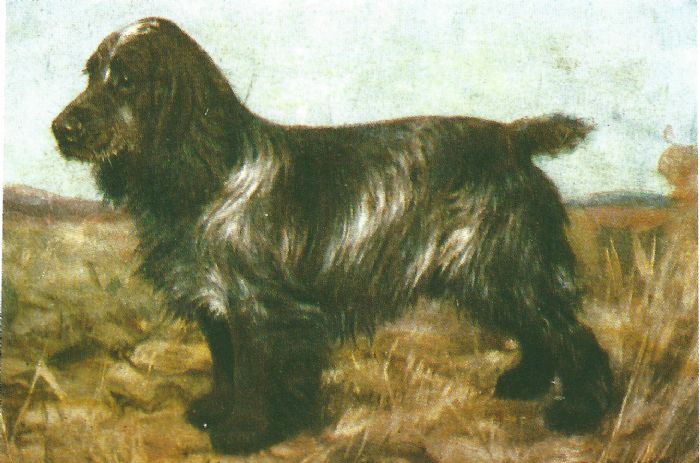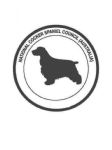The Development of the Cocker Spaniel

by C.C. JENKINS
Source: Dogs Australia Extended Breed Standard
The origin of the Cocker Spaniel is lost in the mists of antiquity. All that can be said with certainty is that spaniel-type dogs existed in the Mediterranean region some 3000 years ago. Some writers believe that the long-eared dogs were observed in the Roman province of Spain and were taken to Europe, hence to Britain by the Romans.
In the literature of the Middle Ages, mention is made of “Spaynels” which were used to seek game and to drive birds into the nets of hunters or to flush them for the hawks. There is evidence that these dogs were highly valued as working dogs and pets.
They were well known in the time of the Tudor Monarchs. Henry VIII, a keen sportsman, had a kennel of spaniels. During this period mention was made in sporting literature of colours. Orange and white or red and white appear to have been popular, and blacks and reds were observed.
The advent of the Stuart Kings led to greater popularity for the spaniel. Van Dyck’s famous picture of the three eldest children of Charles I shows two orange and white spaniels. These do not appear to have been as small as the toy spaniels; yet not as sturdy as the modern Cocker. These dogs were greatly loved by Charles II, and were kept by Queen Anne and the first great Churchill, whose “Blenheim” dogs were widely known.
By the end of the 18th Century, three distinct types had emerged; the toy spaniels, the springer and the wood cocking spaniel (a medium sized dog used to hunt and flush woodcock for the shooters). By this time, there was a wide range of acceptable colours and there were variations in type from owner to owner, and from one district to another.
It was in the latter part of the 19th Century that Spaniels began to be shown as well as worked, and a Spaniel Club was formed to promote spaniel breeds. The beginning of this Century saw the formation of the Cocker Spaniel Club of England. This Club began the work of drawing up a breed Standard. Those who drew up this early Standard had in mind the work the dog was expected to do, that is to hunt (in packs) for woodcock.
For this purpose the shooters needed a small, active, strong dog, sturdy enough to work cheerfully and tirelessly all day, and day after day, and sufficiently small and strong to go through thick undergrowth, following the scent of game. Anyone who has seen a spaniel working in thick cover will know that it must be a dog of stamina, high courage, intelligence and keen scenting power. In 1902 it was assumed that such a dog would weigh approximately 25 to 28 pounds. (In the early shows those over 25 pounds were classified as Field Spaniels and those under 25 pounds as Cockers.)
At that time the range of guns available to game shooters was very limited. Therefore they preferred to use little dogs, which worked close up to the gun. They were unable to shoot far enough to keep up with bigger and more active dogs, ranging further ahead. However, with improvement in the quality of powder available, shooters suddenly found that they could shoot game at a greater distance. Dogs capable of moving out, and working well ahead of the hunters were needed.
The type of Cocker Spaniel favoured in the show ring at the turn of the Century no longer completely satisfied the needs of the sportsmen, and demand grew for a dog capable of retrieving as well as finding game - a good “all rounder” that would hunt as an individual rather than as a member of a pack. This was the type of dog that Mr Richard Lloyd, famous father of the famous H. S. Lloyd (of Ware) had in mind. When judging at Crufts, Mr Richard Lloyd, a keen shooting man, created a sensation by putting up a little black bitch, Ch. Jetsam Bowdler.
This bitch was taller on leg than most of her contemporaries, closer to the beautifully balanced Cocker of today. She was a bitch with liberty of action - the type that the sportsmen wanted. Other judges followed Mr Lloyd’s example and it became apparent that the day of the little, short-legged, “drainpipe” Cocker was over, and the era of the beautiful modern Cocker had dawned.
The lack of exaggerations in the breed, its beauty, moderate size and gay temperament made it acceptable to sportsmen, to exhibitors and as a pet. A number of glorious specimens, some of the best of all time, appeared on the show bench.
The period between the two World Wars might be said to have been the “Golden Age” of the breed.
Registrations soared, and the names of famous dogs and bitches became household words throughout Britain and, indeed, the world. Cockers topped the list of entries at all major shows, and became pets in homes in every civilised country. It is interesting to note that in this, their heyday, they remained close to their original purpose for existence. Many participated in field sports wherever they lived. Also, in order to lay claim to the title of “Champion” show winners in Britain were required to do more than win in the ring.
They had to qualify in field work, passing simple tests to prove that they were not gun-shy and that they were willing and able to hunt game. Many people believe that it was a retrograde step when this qualification was removed, as it did, if nothing else, serve to remind breeders and judges of the work the dog was designed to do, of the temperament it would need to have, and that it was not only intended to “make a pretty picture”.
We have all seen and admired many Cockers that were very beautiful and very glamorous dogs; but it is well to remember that this is not their sole purpose in life; but merely the icing on the cake. The very popularity of the Cocker proved detrimental to the breed. All through this period there were a number of very knowledgeable and conscientious people breeding these dogs - some of the greatest breeders of all time.
However, there were others who were only interested in making money out of the popular breed, the owners of the “puppy factories”. Many breeds have been destroyed by such people who have no real interest in providing good dogs, only dogs for sale.
In the 1950’s a downward trend in the popularity of the breed began. Registrations fell as did show entries; other breeds going to the top of the list. It is interesting to note that this downward trend was world wide, and accompanied by a decrease in the number of Cockers used in field work.
The late Fifties and Sixties were years of crisis for the Cocker Spaniel. English breeders, many with a life time of study and dedication to the welfare of the breed, took a good, hard look at their dogs, and, being realists were able to perceive the problems which had arisen and which were, in the main, responsible for the decline in popularity.
From these members of the Cocker Spaniel Club of England, came the demand that the standard of the breed be rewritten so that it could be understood more clearly by breeders, exhibitors and judges. They hoped this would lead to a concerted effort to eradicate undesirable traits, which had appeared, and to improvement of the breed.
In the late Sixties the Cocker Spaniel Club (UK) and the Breed Council (UK) undertook the great task of rewriting the Standard. The aims of this exercise were not to change the breed; but to clarify what had been written before – to word the Standard so that everyone would understand what was required; also to express in writing some facts about the breed which were well known and taken for granted by experts, but never actually put into words.
A revised Standard was produced in 1969 and also in 1986, when all English Breed Standards were changed in order to ‘standardise’ them.
**Photo courtesy Cocker Spaniel (English) by George Caddy (1993) page 18.
